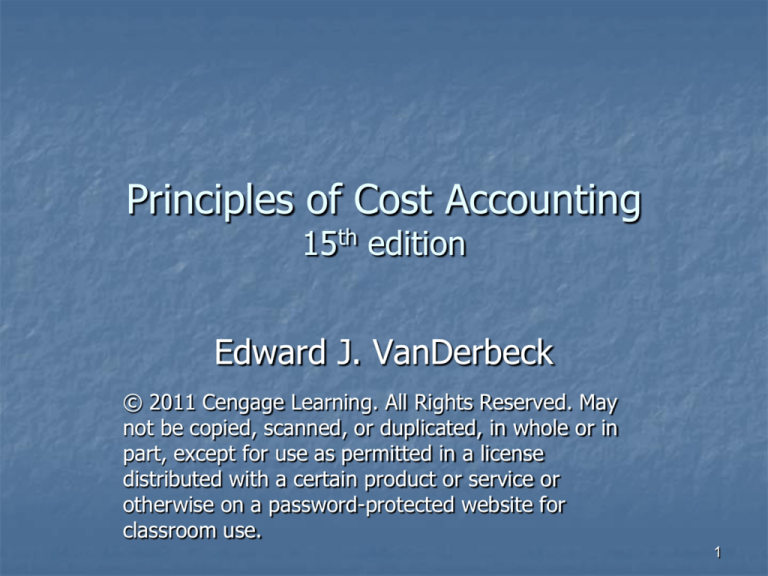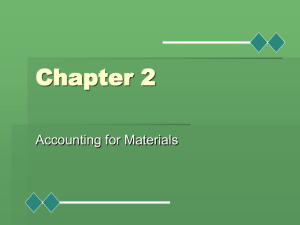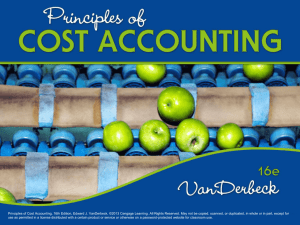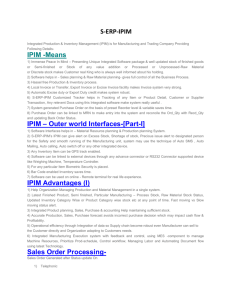
Principles of Cost Accounting
15th edition
Edward J. VanDerbeck
© 2011 Cengage Learning. All Rights Reserved. May
not be copied, scanned, or duplicated, in whole or in
part, except for use as permitted in a license
distributed with a certain product or service or
otherwise on a password-protected website for
classroom use.
1
Chapter 2
Accounting for Materials
2
Learning Objectives
LO1 Recognize the two basic aspects of
materials control.
LO2 Specify internal control procedures for
materials.
LO3 Account for materials and relate
materials accounting to the general
ledger.
3
Learning Objectives (cont.)
LO4 Account for inventories in a
just-in-time (lean production) system.
LO5 Account for scrap materials, spoiled
goods, and defective work.
4
An Effective
Cost Control System
1.
2.
3.
4.
5.
6.
A specific assignment of duties and responsibilities.
A list of individuals who are authorized to approve
expenditures.
An established plan of objectives and goals.
Regular reports showing the differences between goals
and actual performance.
A plan of corrective action designed to prevent
unfavorable variances from recurring.
Follow-up procedures for corrective measures.
5
Physical Control of Materials
Limited access.
Segregation of duties.
Accuracy in recording.
6
Controlling
the Investment in Materials
Maintaining the appropriate level of raw
materials is one of the most important objectives
of materials control.
An inventory of sufficient size and variety for
efficient operations must be maintained.
Management should consider other working
capital needs in determining inventory levels.
Adequate planning and control is required.
7
Order Point
A minimum level of inventory should be
determined for each type of raw material,
and inventory records should indicate how
much of each type is on hand.
Order point is the point at which an item
should be ordered.
8
Order Point (cont.)
The following items need to be taken
into consideration when ordering:
1.
2.
3.
Usage – anticipated rate at which the material will
be used.
Lead time – estimated time interval between the
placement of an order and the receipt of the
material.
Safety stock – estimated minimum level of
inventory needed to protect against stockouts.
(Daily usage X Lead time) + Safety stock =
Order point
9
Economic Order Quantity (EOQ)
The optimal quantity to order at one time.
Minimizes the total order and carrying costs over a
period of time.
Ordering costs may include the salaries and wages of
purchasing personnel, communication costs, and materials
accounting and record keeping.
Carrying costs are the costs that a company may incur in
storing materials. These costs may include materials storage and
handling costs, interest, insurance, and property taxes, loss due
to theft, deterioration, or obsolescence, and records and supplies
associated with carrying inventory.
10
Calculating EOQ
EOQ = Economic
Order Quantity
C = Cost of placing an
order
EOQ =
N = Number of units
required annually
K = Annual carrying
cost per unit of
inventory
2CN
K
11
Materials Control Procedures
Materials Control Personnel
Purchasing Agent – employee responsible for buying
the materials needed.
Receiving Clerk – employee responsible for
supervising the receipt of incoming shipments.
Storeroom Keeper – employee in charge of materials
after they have been received.
Production Department Supervisor – employee
responsible for supervising the operational functions
within the department.
12
Control During Procurement
When the order point is reached the
procurement process begins.
Supporting documents are essential to
maintain control during the procurement
process.
13
Documents Common to the
Procurement Process
Purchase Requisition – the form used to notify the
purchasing agent that materials are needed.
Purchase Order – the purchase requisition that gives
the purchasing agent authority to order the materials.
Vendor’s Invoice – the invoice from the vendor that
should be compared to the purchase order.
Receiving Report – the form that the receiving clerk
uses to count and identify the materials received.
Debit-Credit Memorandum – the document that is
used when the shipment of materials does not match the
order and/or the invoice.
14
Control During
Storage and Issuance
Materials Requisition
Prepared by the authorized factory personnel
to withdraw materials from the storeroom.
Returned Materials Report
Describes the materials being returned to the
storeroom and the reason for the return.
15
Accounting for Materials
The materials accounting system must be
integrated with the general ledger.
Purchases are recorded as debits to
materials in the general ledger.
Materials account is supported by a
subsidiary stores or materials ledger in
which there is an individual account for
each item.
16
Determining
the Cost of Materials Issued
In selecting the method to be used, the
company should review their accounting policies
and the federal and state tax regulations.
The flow of materials does not dictate the
flow of costs.
Flow of materials – the order that materials are
issued for use in the factory.
Flow of costs – the order in which unit costs are
assigned to materials.
17
Cost Flow Methods
First – In, First – Out Method (FIFO)
Assumes that materials used in production are costed
at the prices paid for the oldest materials and the
ending inventory is costed at the prices paid for the
most recent purchases.
Last – In, Last – Out Method (LIFO)
Assumes that materials used in production are costed
at the prices paid for the most recently purchased
prices, and the ending inventory is costed at prices
paid for the earliest purchases.
18
Cost Flow Methods (cont.)
Moving Average Method
Material issued and the ending inventory are
costed at the average price. This average unit
price is computed every time a new lot of
materials is received and it continues to be
used until another lot is purchased.
19
Accounting Procedures
The purpose of materials accounting is to
provide a summary from the general
ledger of the total cost of materials
purchased and used in manufacturing.
All materials issued during the month and
materials returned to stock are recorded
on a summary of materials issued and
returned form.
20
Selected Materials Accounting
Transactions
Materials purchased from vendor.
Materials
XX
Accounts Payable
XX
Materials issued to production.
Work in Process
Materials
XX
XX
21
Selected Accounting
Transactions
Payment to vendor for invoice.
Accounts Payable
XX
Cash
XX
Transfer finished work to finished goods.
Finished Goods
Work in Process
XX
XX
22
Selected Sales-Related
Accounting Transactions
Sale of finished goods on account.
Accounts Receivable
XX
Sales
Cost of Goods Sold
XX
XX
Finished Goods Inventory
XX
Collection of cash from customer.
Cash
Accounts Receivable
XX
XX
23
Just-In-Time (JIT)
Materials Control
Materials are delivered to a factory
immediately prior to their use in
production.
Reduces inventory carrying costs.
Reducing inventory levels through JIT may
increase processing speed.
Backflush costing is the accounting
system used by JIT systems.
24
Traditional and Backflush
Accounting Systems
Traditional System
Materials
Accounts Payable
xx
Work in Process
Materials
xx
Work in Process
Payroll
xx
Factory Overhead
Various Credits
xx
xx
Backflush System
Raw and In-Process
Accounts Payable
xx
xx
No entry
xx
xx
xx
Conversion Costs
Payroll
xx
Conversion Costs
Various Credits
xx
xx
xx
25
Traditional and Backflush
Accounting Systems (cont.)
Traditional System
Work in Process
Factory Overhead
xx
Finished Goods
Work in Process
xx
Cost of Goods Sold
Finished Goods
Backflush System
No entry
xx
xx
xx
xx
Finished Goods
Conversion Costs
Raw and In-Process
xx
xx
Cost of Goods Sold
Finished Goods
xx
xx
xx
26
Accounting for Scrap Materials
Scrap may be
considered waste
materials from the
production process.
These are materials
that can not be used
in the production
process.
Journal entry if the value of
scrap is relatively high
Scrap Materials
XX
Scrap Revenue
Cash
XX
XX
Scrap Materials
XX
Journal entry if the value of
scrap is small.
Cash
Scrap Revenue
XX
XX
27
Accounting for Spoiled Goods
and Defective Work
Spoiled work has imperfections that
cannot be economically corrected. The
loss can be treated as part of the cost of
the job or charge to Factory Overhead.
Defective work has imperfections that
are correctable. The extra costs are either
charged to the job or Factory Overhead.
28




